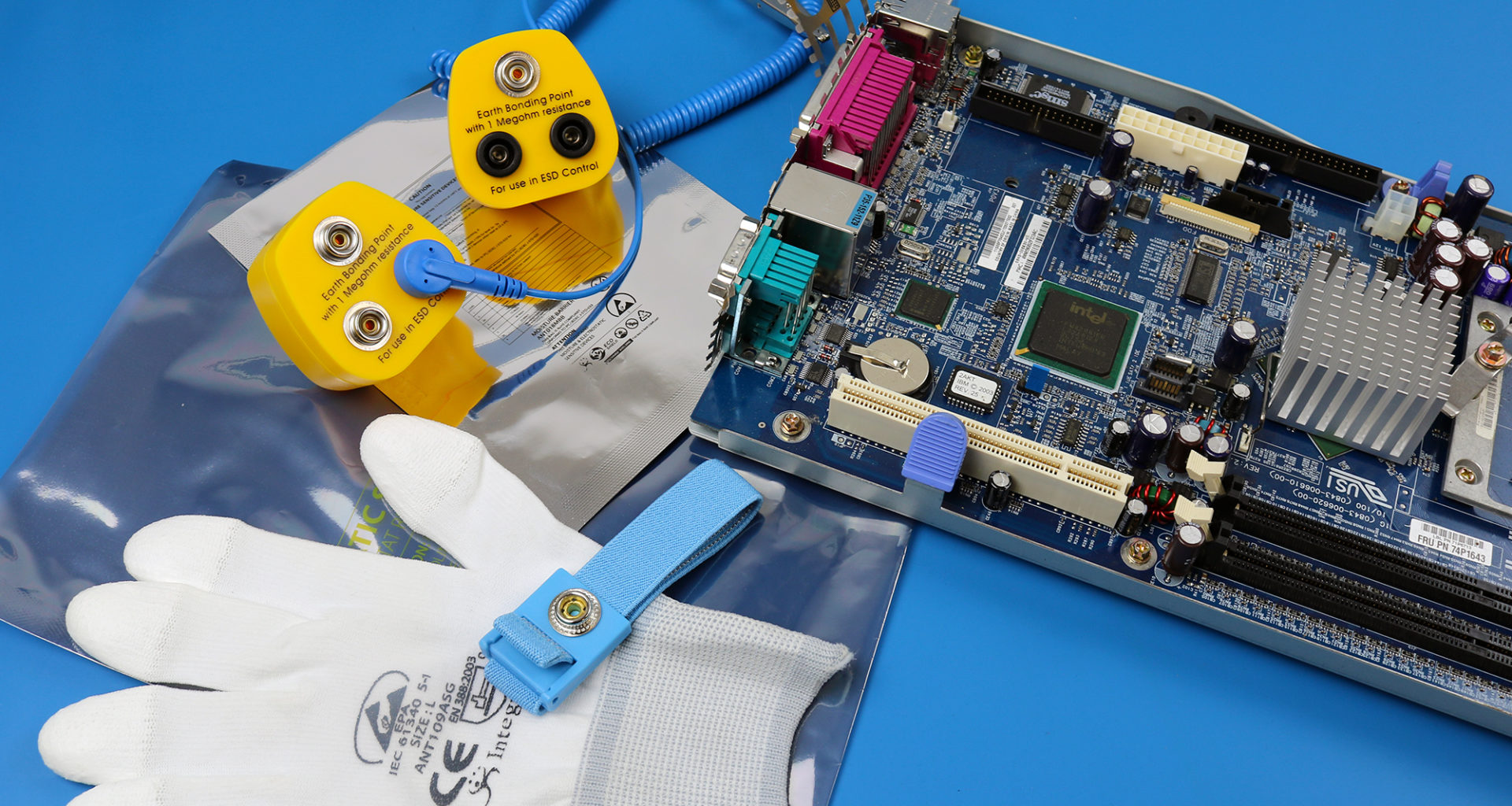It is vital that appropriate measures are taken to safeguard against electro-static discharge (ESD) incidents, otherwise there can be severe consequences. The objective of this article is to outline the measures necessary for the entire supply chain to be properly prepared. It will cover the packaging that should be used – so electronic hardware passing between manufacturers, systems integrators and OEMs, or being handled by warehouse operatives and engineering staff, can be kept from causing system failure. Staff/workstation protection equipment will also be described.
Implications of ESD
If not suitably protected against, ESD can cause harm to sensitive system-critical electronic devices, as the charge tries to find a route to ground. Device contacts, semiconductor junctions and insulation layers are among the places where damage is most likely to be witnessed.
ESD events can thereby have a major impact from a system reliability perspective, as well as leading to capital cost and operational downtime penalties when repair/replacement work has to be carried out.
Implementing protection
The easiest way to protect from ESD during transportation is via packaging. Through use of appropriate packaging selection, it is possible to mitigate the effects of static accumulation and to safeguard sensitive items of electronic components against ESD as they are transported from different sites. For such reasons, an understanding of the different forms of packaging is essential.
Packages must be able to counteract the potential for static charge to the build-up within their interiors. They may also need to withstand (and dissipate) charges from the external environment to which they are exposed.
A key attribute for any form of anti-static packaging will be a high surface resistance value, with constituent materials being chosen that are capable of maximising this, and for which the ASTMD257-78 standard sets the test methods used. Compliance with the IEC/EN 61340-5 standards framework will also be crucial. Adopted by both the European and worldwide engineering community as a whole, this framework defines the properties that packaging should possess in order to protect sensitive devices from ESD events. Comprehensive testing is done to evaluate the packaging, as well as the materials that the packaging is made from, so that it can be verified that guidelines are adhered to.
Key packaging options
There are three basic types of bags that can be employed, depending on what degree of protection is called for. The first of these bag types is predominantly concerned with the presence of moisture. The RND Lab dehumidifier bags from Distrelec come in both 125mm x 50mm and 125mm x 93mm package sizes. They are based on a granular amorphous silica construction with narrow pores (maximum 3nm diameter). As these granules remain physically unchanged whether they are dry or saturated with water, any devices that these bags are keeping moisture can be kept safe.

These bags are complemented by RND Lab’s antistatic bags, which have an innate ability to dissipate static charge to ground (so there is no gain in charge experienced when they are rubbed against other materials). They are made from a low-density polyethylene (LDPE) thermoplastic film, with surface resistance values reaching 1010 Ohm/sq and a static release time >2secs. These bags are offered in a number of different form factor options (with dimensions up to 305mm x 457mm). Re-closable options are available if required.
While antistatic bags prevent the build-up of charge on their surfaces, and are suitable for preventing components being brought into an ESD-protected area from causing problems, they are not able to protect more sensitive components or boards from possible ESD-related damage – such as an ESD strike coming from another source. Here static shielding bags are able to go further. They present a conductive barrier to defend the components they are carrying against all forms of electro-static hazard.
The RND Lab static shielding bags have surface resistance values reaching 1010Ohm/sq, and conform to all the relevant ESD standards requirements. They are available in a broad variety of size options, and each has a dual seal configuration. These bags comprise multiple different layers. Firstly, there is a static dissipating polyester outer layer alongside a static dissipating polyethylene (PE) inner layer. Then there is a metallised shield layer that lies between these, which is accompanied by a polyester dielectric.
Compliant with EN 61340-5 requirements, the ESD grid tapes that Distrelec supplies are advised for sealing packages when ESD is identified as an issue. Made from a silicone-free low residue PP compound, they have a typical surface resistance of 107Ohm/cm.


Larger requirements
The ESD shipping boxes from RND Lab provide asafe and cost-effective way of transporting ICs and modules, with 99.9% attenuation being achieved. They are manufactured from corrugated fibreboard with a Corstat conductive coating that conforms to the surface resistivity requirements set out by the ASTMD257-78 standard. Soft antistatic foam or high-density pin stick grade conductive foam can be fitted, depending on customers’ particular requirements. An extensive shelf life of at least 10 years is supported.

Through Distrelec, RND Labstackable ESD transport containers can also be sourced for situations where heightened capacities are needed. Made from polypropylene (PP), these rugged units have dimensions going up to 400mm x 300mm x 220mm. They have a volume resistances of 10¹⁰Ohm/cm being attained.
Protecting the workforce
As well as in relation to transportation and storage, addressing ESD issues at workstations and protecting members of staff is also clearly critical. The ANSI/ESD S20.20 standard sets out all the fundamental requirements that are needed for implementing an ESD control program within a workplace.
RND Lab’s thermoplastic moulded ESD earth bonding plugs have a 1MOhm resistance value. They provide operatives within an ESD-protected area, and other items found there, with a straightforward connection to mains earth.

Distrelec also offers ESD workstation kits that allow tasks to be undertaken by engineering staff in a completely static controlled setting. These kits each feature a mat that dissipates static charge from any items placed onto them, plus an earth bonding plug, straight earth lead, coiled earth lead, wrist strap and self-adhesive vinyl ESD-protected area signage. The mats (covering dimensions of 600mm x 1200mm) exhibit a strong friction coefficient to prevent delicate components from sliding across their surfaces. They are made from a heat-resistant material that does not melt/burn if hot debris from soldering activity lands on them.

Other RND mats include the ESD bench mat. This is made from synthetic rubber and anti-static (conductive) and static-dissipative materials. It is suitable for use in microelectronic industry workshops or laboratories.

Intended for handling sensitive electronic components without the risk of damage, RND Lab ESD gloves have a knitted nylon body with polyurethane (PU) coated fingertips. The surface resistivity reaches up to 108Ohm/sq. ESD heel grounders with double layer conductive cups, disposable 3-ply filtered facemasks, non-magnetisable corrosion-resistant epoxy coated ESD tweezers, A5 antistatic notebooks with high-density PP covers, and carbon alloy cutting pliers are also stocked.
Some additional recommended products include ESD field service kits that are designed for use in the field, where there is no access to an ESD-protected area. This means that engineers can be sure of working safely, even in remote locations. Furthermore, for personnel that suffer from allergic reactions, companies should make certain that there are antistatic adjustable hypoallergenic wrist strap sets available. Those that Distrelec offers from RND have comfortable wristbands, each with a 10mm adjustable push stud. They come with sturdy coiled earth leads, featuring either a 4mm banana plug or a 10mm press stud.

Finally, to enable safe disposal of electronic hardware in an ESD-protected zone within a manufacturing facility, Distrelec offers ESD waste sacks. For use with conductive bins, these are made from 32.5µm thick antistatic PE and have a double-bag arrangement. They are sterilised through exposure to gamma rays. Their surface resistance is 1011Ohm/sq, and they can cope with heavy-duty treatment (displaying a 3000PSI tensile strength). Various, different colour options can be selected from.
Conclusion
The regularity of ESD events occurring is expected to escalate, with the prospect of this leading to greater numbers of system-level failures down the line. To minimise this risk, superior protection needs to be embedded into every stage of the component supply chain, as well as engineers’ workflows. Distrelec has an expansive portfolio of products to help with this, as well as numerous products for ensuring ongoing operative safety. Click here to find out more.











